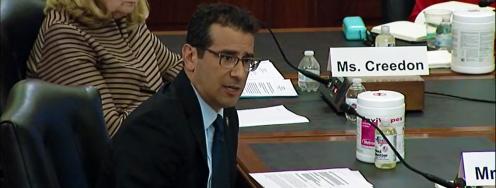Legislation to Reduce Nuclear Weapons Spending Introduced
On the radar: SANE Act and REIN-IN; Maddow on the arsenal; Senate letter on Iran; Iran cuts stockpile of uranium; North Korea missile launches; Uncertain nuclear waste plan; Castle Bravo after 60; and the Nuclear Genie.
On the radar: SANE Act and REIN-IN; Maddow on the arsenal; Senate letter on Iran; Iran cuts stockpile of uranium; North Korea missile launches; Uncertain nuclear waste plan; Castle Bravo after 60; and the Nuclear Genie.
March 3, 2014 | Edited by Lauren Mladenka and Geoff Wilson
SANE - “A high-profile U.S. Senate critic of nuclear-weapons spending on Friday introduced a bill that would cut $100 billion over the next decade in arsenal outlays,” writes Rachel Oswald in the National Journal. The Smarter Approach to Nuclear Expenditures (SANE) Act, filed by Sen. Edward Markey (D-MA) and co-sponsored by Sen. Jeff Merkley (D-OR), would reduce the number of ballistic missile submarines, do away with any potential nuclear mission for the F-35, postpone development of a new long-range strike bomber, cut nuclear weapon modernization programs and missile defense, and cancel plans to build new facilities for fissile-material processing.
--Rep. Earl Blumenauer (D-OR) introduced a companion bill, the Reduce Expenditures in Nuclear Investments Now (REIN-IN) Act, in the House last Friday. http://bit.ly/1kNlI3i
--Full text of the SANE Act available here. (pdf) http://1.usa.gov/1gN6714
Statements - “We need to stop pouring billions into the nuclear weapons programs of the past and instead prioritize our nation’s pressing needs. The SANE Act will cut spending on outdated, wasteful nuclear weapons and related programs over the next ten years and will strengthen our long-term economic and national security,” Senator Markey said in a press release on the SANE Act.
--“We can make the world, and our country, safer by reducing spending on these programs that we haven’t used in 69 years and are better suited for the Cold War than the strategic challenges we face today,” said Rep. Blumenauer. Statements here. http://1.usa.gov/1luyGGu
REIN-IN - “We must significantly reduce U.S. spending on nuclear weapons, delivery systems, and related programs. Today, the United States spends more in this arena than it did at the height of the Cold War… Worse, there are plans in the works to spend billions of dollars modernizing our nuclear stockpile of missiles, submarines, and bombers, committing us to decades more of waste. We need to change direction,” writes Rep. Blumenauer.
--“The Reduce Expenditures in Nuclear Infrastructure Now (REIN-IN) Act of 2014, [would] save $100 billion over 10 years by reducing unnecessary nuclear weapons programs… I look forward to working with the president and Congress to pass the REIN-IN Act, which will not only reduce overall spending, but reprioritize investments that will actually make the United States safer, more livable, and economically secure.” Read the full piece for The Huffington Posthere. http://huff.to/OT1POv
Maddow on nukes - “If we’re thinking about places to cut the budget without hurting national security and military readiness, our ground-based missiles — [the nuclear] missiles on the high plains — are blinking red for attention,” writes Rachel Maddow in The Washington Post. “Although no one has had to prevent an accidental missile launch by parking an armored vehicle on top of the silo doors since the 1980s (true story), we’re just not doing a great job handling the responsibility of those Minuteman 3s. And we’re not so much failing as succumbing to inevitability: In the absence of any realistic mission in which those missiles would be used, maintaining morale and 100 percent error-free rigor over decades is an almost existentially impossible challenge.”
--“At a time of cuts and reorganization, when hard decisions must be made about what to save and what to let go, continuing to throw billions of dollars down those silos is a failure of accountability and a failure to be realistic about what kind of wars we might conceivably fight in the future,” Maddow says. Full piece here. http://wapo.st/NGnZ57
Quote - “If we don't change policy soon, the U.S. will commit itself to spend $1 trillion on nuclear systems over the next 30 years. We can find better ways to spend our scarce resources,” writes Jon Wolfsthal in a letter to the Los Angeles Times. http://lat.ms/1fCdjRa
Senate letter on Iran - In a letter to the President, Sens. Menendez (D-NJ), Graham (R-SC), Schumer (D-NY), Kirk (R-IL), Coons (D-DE) and Ayotte (R-NH) outline what they see as Congress’ role in nuclear negotiations with and their outline for a final deal. Full letter here. (pdf) http://bit.ly/1hzXrOh
Taking stock - “The head of the U.N. nuclear agency says Iran has cut its stock of uranium that is closest to atomic weapons-grade,” AP reports. Full story here. http://wapo.st/1fCagsl
Tweet - @Nickolas_Roth: Belfer nuclear security event w/ Matt Bunn, Laura Holgate, Samantha Pitts- Kiefer, Gary Samore live online tonight: http://bit.ly/1mQezUC
Missile tests - “North Korea fired two short-range missiles into the sea Monday in the second such launch in less than a week, amid ongoing annual military exercises between Seoul and Washington,” reports Hyung-Jin Kim for the AP. “The launches appear to be a continuation of North Korea's protest of the drills it calls a preparation for an attack, and to test the country's weapons systems. They followed South Korea's announcement that North Korea last Thursday fired four short-range Scud missiles with a range of more than 200 kilometers (about 125 miles) into the North's eastern waters.” Full report here. http://abcn.ws/1dSP6Ao
Personnel assessment - “The U.S. Air Force is moving to simplify its program for ensuring that personnel with nuclear-weapons responsibilities are fit to perform their jobs” through the Personnel Reliability Program, reports Rachel Oswald for Global Security Newswire. Get the full story here. http://bit.ly/1fCc0Si
Future of nuclear waste uncertain - “It is unclear how the United States will handle remnants of past nuclear-arms production following recent incidents at its sole burial site in New Mexico. Federal administrators, contractor operators and political figures said it is too early to consider possible consequences of the Waste Isolation Pilot Plant's closure after the detection of escaped contaminants in and around the facility this month.” However, “Overseers have suggested it may be at least weeks before personnel can re-enter the subterranean area of the site, where 13 workers were apparently exposed to radiation.”
--“The halt in operations -- which also came shortly after an unprecedented but apparently unrelated fire -- has forced the suspension of all waste transfers to the site near Carlsbad, N.M. Senator Tom Udall (D-N.M.) said there is a ‘paramount’ need to rapidly finish shipping almost 4,000 waste tanks away from the Los Alamos National Laboratory, where the materials came under threat from wildfires in 2011… Separately, developments at the waste site have placed on hold a proposal for the facility to receive substances deemed more hazardous.” Full report from Global Security Newswire here. http://bit.ly/1fCmfzZ
Events:
--United States Senate Committee on Armed Services, Subcommittee on Strategic Forces: Defense Authorization Request for Fiscal Year 2015 and the Future Years Defense Program. Wednesday, March 5, 9:30AM. SH-216, Hart Senate Office Building. http://1.usa.gov/1d1Q40t
--United States Senate Committee on Armed Services, Subcommittee on Strategic Forces: Hearing on on nuclear forces and policies in review of the Defense Authorization Request for Fiscal Year 2015 and the Future Years Defense Program. Wednesday, March 5, 2:30PM. R-222, Russell Senate Office Building. http://1.usa.gov/1hqabH6
--“Iran’s Nuclear Deal: The Road Ahead.” Discussion with Michael Adler and Reza Marashi March 5 from 12:00-1:00 at the Wilson Center, 1300 Pennsylvania Ave. NW, 5th floor. RSVP here. http://bit.ly/1fCesSP
--“Iran Nuclear Deal: Breakthrough or Failure?” Discussion with Robert Einhorn, Karim Sadjadpour, and Bret Stephens, and Reuel Gerecht. March 11 from 5:00-7:00 at George Washington University, Jack Morton Auditorium, 805 21st St. NW. RSVP here. http://bit.ly/1hFYrQn
History lessons:
Remembering Castle Bravo - “March 1, 2014, is the 60th anniversary of the Castle Bravo nuclear test... the first test of a deliverable hydrogen bomb by the United States, proving that you could not only make nuclear weapons that had explosive yields a thousand times more powerful than the Hiroshima bomb, but that you could make them in small-enough packages that they could fit onto airplanes. It is was what truly inaugurated the megaton age...As a technical demonstration it would be historically important even if nothing else had happened.”
--“But nobody says something like that unless other things — terrible things — did happen. Two things went wrong. The first is that the bomb was even more explosive than the scientists thought it was going to be. Instead of 6 megatons of yield, it produced 15 megatons of yield, an error of 250%, which matters when you are talking about millions of tons of TNT...The second problem is that the wind changed. Instead of carrying the copious radioactive fallout that such a weapon would produce over the open ocean, where it would be relatively harmless, it instead carried it over inhabited atolls in the Marshall Islands. This necessitated evacuation, long-term health monitoring, and produced terrible long-term health outcomes for many of the people on those islands.” Read the full piece by Alex Wellerstein for Restricted Data here. http://bit.ly/1mQdT1G
Doesn’t grant 3 wishes - “The Cold War was full of crazy ideas. No nuclear weapon was too big. No munition was too small. They were even used as warheads for anti-aircraft missiles. Beginning in the 1950s, the Air Force developed nuclear anti-air missiles that would be built by the thousands. The result—the MB-1/AIR-2 Genie—was the most powerful air-to-air missile ever made in America.”
--“The Genie was a short-range unguided missile. With the [W-25 warhead] attached, the huge blast compensated for the missile’s inaccuracy. As long as it got within a quarter-mile of its targets, the weapon would destroy them. To get this unguided atomic weapon away from the pilot and into the enemy’s bomber formations as quickly as possible, the Genie’s solid-rocket motor accelerated the missile to Mach 3.3 during its two-second burn, putting about six miles of distance between its launch point and detonation. The total flight time was 12 seconds. During those precious seconds, the interceptor pilots had to get away from the weapon as fast as they could—while the enemy bomber crews dealt with the incoming nuke.
--Over 3,100 Genies entered the U.S. stockpile between 1956 and 1963, and the missile wasn’t retired until 1988, when the end of the Cold War brought the demise of the F-106, the anti-aircraft nuke’s only remaining carrier.” Read the full tale of insanity from Steve Weintz for War is Boring here. http://bit.ly/1cnPjAW



